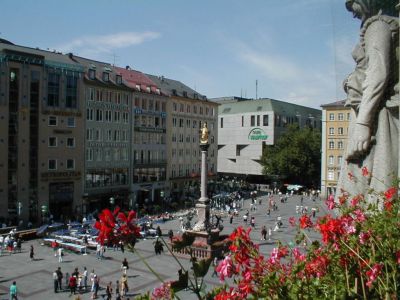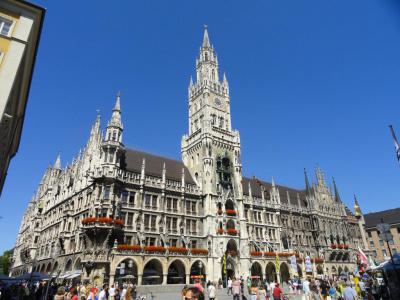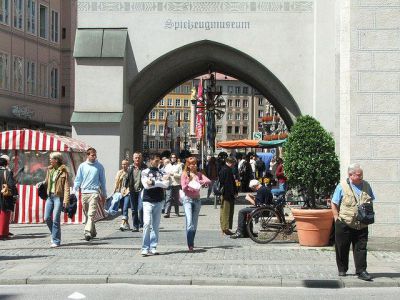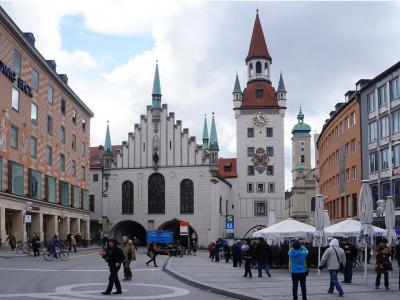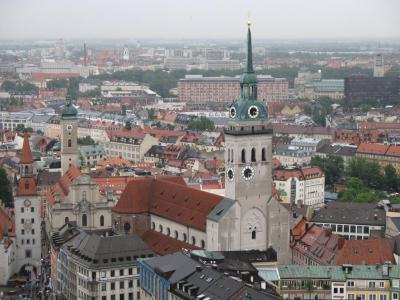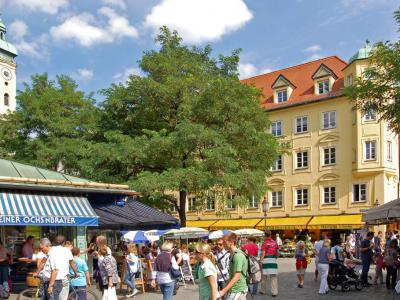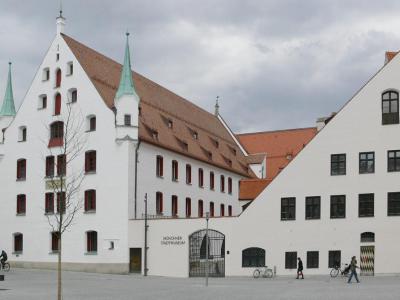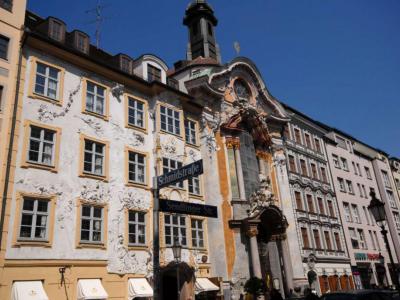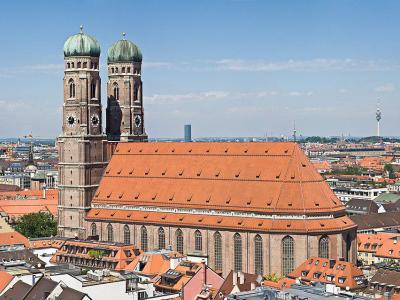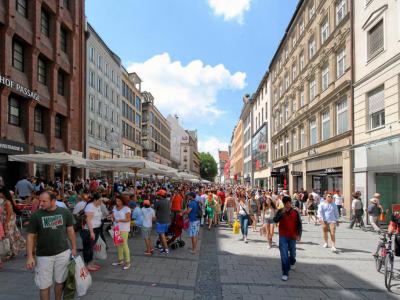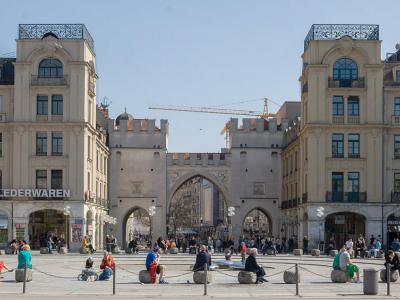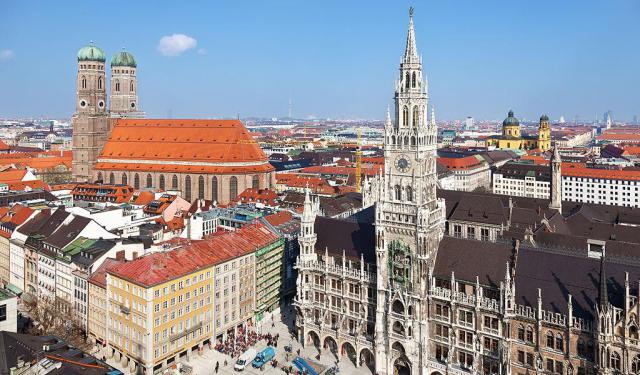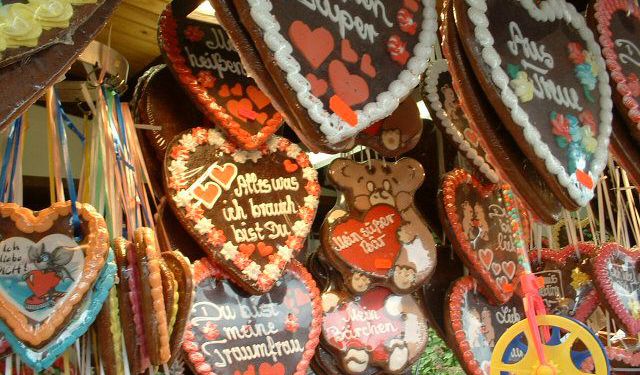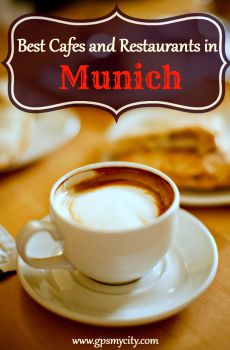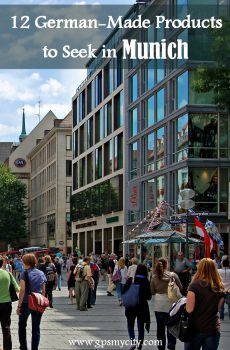Audio Guide: Old Town Walking Tour (Self Guided), Munich
Munich’s Old Town, known as the Altstadt, unfolds across the western bank of the River Isar-a captivating blend of medieval charm, architectural brilliance, and deep cultural roots. As the historic heart of the Bavarian capital, it’s more than just a preserved district-it is is listed as a historical monument and is a living museum – “where the past harmonizes with the present in a grand composition.”
At the center lies Mary’s Square, Munich’s main gathering place since the 12th century. It’s framed by some of the city’s most iconic buildings, none more striking than the New Town Hall. With its towering neo-Gothic façade and the beloved Glockenspiel, it draws daily crowds eager to watch the life-sized figurines dance through scenes from the city’s past.
A short stroll to the south brings you to the Farmer’s Market-an open-air feast for the senses. Here, you’ll find everything from fresh fruits and cheeses to traditional Bavarian fare and international treats. Grab a bite, relax in the beer garden, and soak in the local rhythm.
No visit to the Old Town would be complete without a look at the Cathedral of Our Lady, crowned by its unmistakable twin towers. And for those seeking quieter wonders, Saint Peter’s Church or the ornate jewel-box interior of the Baroque-style Asam Church are not to be missed.
Exploring the winding lanes, cozy courtyards, and expansive squares of the Old Town is like stepping into a story that’s still being written. So don’t just read about Munich-step into it. Take your time, look up, listen close, and let this walking tour lead you into the city’s heart.
At the center lies Mary’s Square, Munich’s main gathering place since the 12th century. It’s framed by some of the city’s most iconic buildings, none more striking than the New Town Hall. With its towering neo-Gothic façade and the beloved Glockenspiel, it draws daily crowds eager to watch the life-sized figurines dance through scenes from the city’s past.
A short stroll to the south brings you to the Farmer’s Market-an open-air feast for the senses. Here, you’ll find everything from fresh fruits and cheeses to traditional Bavarian fare and international treats. Grab a bite, relax in the beer garden, and soak in the local rhythm.
No visit to the Old Town would be complete without a look at the Cathedral of Our Lady, crowned by its unmistakable twin towers. And for those seeking quieter wonders, Saint Peter’s Church or the ornate jewel-box interior of the Baroque-style Asam Church are not to be missed.
Exploring the winding lanes, cozy courtyards, and expansive squares of the Old Town is like stepping into a story that’s still being written. So don’t just read about Munich-step into it. Take your time, look up, listen close, and let this walking tour lead you into the city’s heart.
How it works: Download the app "GPSmyCity: Walks in 1K+ Cities" from Apple App Store or Google Play Store to your mobile phone or tablet. The app turns your mobile device into a personal tour guide and its built-in GPS navigation functions guide you from one tour stop to next. The app works offline, so no data plan is needed when traveling abroad.
Old Town Walking Tour Map
Guide Name: Old Town Walking Tour
Guide Location: Germany » Munich (See other walking tours in Munich)
Guide Type: Self-guided Walking Tour (Sightseeing)
# of Attractions: 11
Tour Duration: 2 Hour(s)
Travel Distance: 2.7 Km or 1.7 Miles
Author: DanaOffice
Sight(s) Featured in This Guide:
Guide Location: Germany » Munich (See other walking tours in Munich)
Guide Type: Self-guided Walking Tour (Sightseeing)
# of Attractions: 11
Tour Duration: 2 Hour(s)
Travel Distance: 2.7 Km or 1.7 Miles
Author: DanaOffice
Sight(s) Featured in This Guide:
- Marienplatz (Mary's Square)
- Neues Rathaus (New Town Hall)
- Spielzeugmuseum (Toy Museum)
- Altes Rathaus (Old Town Hall)
- Peterskirche (St. Peter's Church)
- Viktualienmarkt (Farmer's Market)
- Munchner Stadtmuseum (City Museum of Munich)
- Asamkirche (Asam Church)
- Frauenkirche (Cathedral of Our Lady)
- Kaufinger Street & Neuhauser Street
- Karlsplatz (Karl's Square)
1) Marienplatz (Mary's Square) (must see)
Right in the center of Munich lies Mary’s Square, the city’s lively, historic core. Established back in 1158, it started out as a busy marketplace and a stage for medieval tournaments and public events. These days, it’s still the place where everything seems to converge-a perfect starting point for anyone exploring the city. Grand buildings rise on all sides, cafés spill onto the streets, and the square hums with energy from morning until night.
The star attraction is the New Town Hall, an elaborate neo-Gothic masterpiece brimming with stone figures, ornate carvings, and the famous Glockenspiel. At 11 a.m., noon, and again at 5 p.m. during the warmer months, the Glockenspiel puts on its quirky performance. Thirty-two mechanical figures spin into action, reenacting Bavarian legends to a soundtrack of bells and music. It’s theatrical, a little over-the-top, and completely delightful.
Across the square, you’ll also find the Old Town Hall, with its storybook tower and a toy museum tucked inside-great if you’re traveling with kids or just enjoy a touch of childhood nostalgia. Meanwhile in the center stands the Column of Saint Mary, raised in 1638 to mark the end of Swedish occupation during the Thirty Years' War. A gilded statue of the Virgin crowns the column-a quiet symbol in a bustling space, and the inspiration for the square’s name.
Street musicians, traditional restaurants, souvenir stalls-there’s always something happening around you. Want to shop? Stroll down Kaufinger Street, one of Munich’s busiest pedestrian avenues. If you’re more in the mood for architecture, the city’s Cathedral, with its distinctive twin domes, is just around the corner.
In short, Mary’s Square offers the perfect snapshot of Munich. Don’t rush through it-it’s a place to linger, look up, and let the city reveal itself one detail at a time.
The star attraction is the New Town Hall, an elaborate neo-Gothic masterpiece brimming with stone figures, ornate carvings, and the famous Glockenspiel. At 11 a.m., noon, and again at 5 p.m. during the warmer months, the Glockenspiel puts on its quirky performance. Thirty-two mechanical figures spin into action, reenacting Bavarian legends to a soundtrack of bells and music. It’s theatrical, a little over-the-top, and completely delightful.
Across the square, you’ll also find the Old Town Hall, with its storybook tower and a toy museum tucked inside-great if you’re traveling with kids or just enjoy a touch of childhood nostalgia. Meanwhile in the center stands the Column of Saint Mary, raised in 1638 to mark the end of Swedish occupation during the Thirty Years' War. A gilded statue of the Virgin crowns the column-a quiet symbol in a bustling space, and the inspiration for the square’s name.
Street musicians, traditional restaurants, souvenir stalls-there’s always something happening around you. Want to shop? Stroll down Kaufinger Street, one of Munich’s busiest pedestrian avenues. If you’re more in the mood for architecture, the city’s Cathedral, with its distinctive twin domes, is just around the corner.
In short, Mary’s Square offers the perfect snapshot of Munich. Don’t rush through it-it’s a place to linger, look up, and let the city reveal itself one detail at a time.
2) Neues Rathaus (New Town Hall) (must see)
In the second half of the 19th century, as Munich was growing rapidly and riding a wave of prosperity, city leaders decided they needed a new home for local government. The Old Town Hall had simply outgrown its purpose. They chose a prominent spot on the south side of Mary’s Square, cleared out around two dozen houses, and set the stage for something grand. Construction began in 1867 and continued all the way to 1909. Overseeing the project was a remarkably young architect-Georg Hauberrisser-just 24 when he started.
What emerged is a prime example of German pseudo-historical architecture-mock-Netherlands Gothic, to be exact. The building features six courtyards and a small garden at the back. Its façade is covered in intricate sculptures that reference Bavarian legends, local saints, and allegorical figures. At the top of the steeple stands a bronze statue of the “Munich Child,” the city’s traditional symbol. The tower also houses the fourth-largest chiming clock in Europe.
Every day, 43 bells ring out as copper figures dance in two scenes: a knightly tournament honoring the wedding of Duke Wilhelm V and Renata of Lorraine, and the legendary “Dance of the Coopers.” That dance, by the way, is still performed in the streets every seven years during Carnival to commemorate the passing of a plague epidemic in the early 1500s. Legend has it that coopers, loyal to the Duke, danced through the streets to inspire courage during tough times. The official dance moves were defined as far back as 1871.
The full carillon performance plays at 11 a.m., noon, and 5 p.m. in the summer, lasting up to 15 minutes depending on the day’s tune. As a whimsical finale, a tiny golden rooster perched above the clock lets out three soft chirps. And when evening falls, figures of a night watchman and the Angel of Peace appear in the upper windows, quietly blessing the “Munich Child” and the city below.
Visitors can ride the elevator to the viewing platform for sweeping views of the city. And beneath the building, the historic Ratskeller restaurant offers not just a good meal, but a truly atmospheric dining experience.
What emerged is a prime example of German pseudo-historical architecture-mock-Netherlands Gothic, to be exact. The building features six courtyards and a small garden at the back. Its façade is covered in intricate sculptures that reference Bavarian legends, local saints, and allegorical figures. At the top of the steeple stands a bronze statue of the “Munich Child,” the city’s traditional symbol. The tower also houses the fourth-largest chiming clock in Europe.
Every day, 43 bells ring out as copper figures dance in two scenes: a knightly tournament honoring the wedding of Duke Wilhelm V and Renata of Lorraine, and the legendary “Dance of the Coopers.” That dance, by the way, is still performed in the streets every seven years during Carnival to commemorate the passing of a plague epidemic in the early 1500s. Legend has it that coopers, loyal to the Duke, danced through the streets to inspire courage during tough times. The official dance moves were defined as far back as 1871.
The full carillon performance plays at 11 a.m., noon, and 5 p.m. in the summer, lasting up to 15 minutes depending on the day’s tune. As a whimsical finale, a tiny golden rooster perched above the clock lets out three soft chirps. And when evening falls, figures of a night watchman and the Angel of Peace appear in the upper windows, quietly blessing the “Munich Child” and the city below.
Visitors can ride the elevator to the viewing platform for sweeping views of the city. And beneath the building, the historic Ratskeller restaurant offers not just a good meal, but a truly atmospheric dining experience.
3) Spielzeugmuseum (Toy Museum)
Housed inside the tower of the Old Town Hall, Munich’s Toy Museum offers a one-of-a-kind glimpse into two centuries of toymaking from around the world. At its core is the private collection of Czech writer, cartoonist, and filmmaker Ivan Steiger and his wife Eva, who opened the place to the public in 1983.
What sets the museum apart is how it presents mechanical toys-not just as objects of nostalgia, but as feats of miniature engineering. Many are displayed in ways that reveal the inner workings, allowing to appreciate the craftsmanship behind each moving part. A narrow spiral stone staircase winds its way through four floors of exhibits, thoughtfully arranged by toy type.
Among the highlights are some of the earliest teddy bears ever made by the legendary Margaret Steiff, along with elegant porcelain dolls crafted by Käthe Kruse. Another standout is a rare French “walking doll” from 1855, complete with a mechanism that moves the arms and legs-and can even simulate speech. Many other dolls on display once belonged to real children, giving them a quiet sense of history and sentiment.
Collectors, nostalgic souls, and curious visitors alike will find something to delight in here: from antique dollhouses and merry-go-rounds to vintage tin cars, trains, copper soldiers, and even Barbie outfits from every era of the iconic doll’s history. Take your time as you explore each floor-these tiny treasures have big stories to tell, and they’re waiting to be discovered.
What sets the museum apart is how it presents mechanical toys-not just as objects of nostalgia, but as feats of miniature engineering. Many are displayed in ways that reveal the inner workings, allowing to appreciate the craftsmanship behind each moving part. A narrow spiral stone staircase winds its way through four floors of exhibits, thoughtfully arranged by toy type.
Among the highlights are some of the earliest teddy bears ever made by the legendary Margaret Steiff, along with elegant porcelain dolls crafted by Käthe Kruse. Another standout is a rare French “walking doll” from 1855, complete with a mechanism that moves the arms and legs-and can even simulate speech. Many other dolls on display once belonged to real children, giving them a quiet sense of history and sentiment.
Collectors, nostalgic souls, and curious visitors alike will find something to delight in here: from antique dollhouses and merry-go-rounds to vintage tin cars, trains, copper soldiers, and even Barbie outfits from every era of the iconic doll’s history. Take your time as you explore each floor-these tiny treasures have big stories to tell, and they’re waiting to be discovered.
4) Altes Rathaus (Old Town Hall)
Before the New Town Hall took over in 1874, the Old Town Hall was where Munich’s city government did its business. Unlike many buildings that were torn down to make way for the new structure, this one remained-preserved as a testament to the city’s commitment to restoration over replacement.
With its dove-grey façade, amber-tiled steeple, and delicate Gothic spires, the Hall captures the essence of its 15th-century origins-though what stands today isn’t an exact replica. Over time, additions like a baroque onion dome and later, an overly enthusiastic attempt at “regothification,” took the structure further from its medieval roots than what the current version reflects. Ironically, the faithful postwar reconstruction you see today may be closer to the spirit of the original than what existed before the Allied bombing.
The oldest surviving element is the 12th-century tower, once part of the city’s medieval fortifications. Today, it houses the Toy Museum, where you’ll find a charming collection of vintage toys-from antique train sets to miniature zoos-spread across four narrow floors connected by a spiral staircase. There's also a gift shop with hand-picked items that make for great souvenirs.
The ceremonial hall still retains its Gothic grandeur, with broad wooden barrel vaults and a frieze of 96 coats of arms lining one wall. Meanwhile, on the building’s side, there's a whimsical surprise: a bronze statue of Shakespeare’s Juliet, a gift from the city of Verona in the 1970s.
But the building also carries a darker legacy. In 1938, Nazi propaganda minister Joseph Goebbels delivered a speech here that triggered the “Night of Broken Glass.” That night of terror saw synagogues burned, Jewish businesses destroyed, and thousands arrested. It’s widely seen as the moment when Nazi anti-Semitic violence escalated into what became the Holocaust.
With its dove-grey façade, amber-tiled steeple, and delicate Gothic spires, the Hall captures the essence of its 15th-century origins-though what stands today isn’t an exact replica. Over time, additions like a baroque onion dome and later, an overly enthusiastic attempt at “regothification,” took the structure further from its medieval roots than what the current version reflects. Ironically, the faithful postwar reconstruction you see today may be closer to the spirit of the original than what existed before the Allied bombing.
The oldest surviving element is the 12th-century tower, once part of the city’s medieval fortifications. Today, it houses the Toy Museum, where you’ll find a charming collection of vintage toys-from antique train sets to miniature zoos-spread across four narrow floors connected by a spiral staircase. There's also a gift shop with hand-picked items that make for great souvenirs.
The ceremonial hall still retains its Gothic grandeur, with broad wooden barrel vaults and a frieze of 96 coats of arms lining one wall. Meanwhile, on the building’s side, there's a whimsical surprise: a bronze statue of Shakespeare’s Juliet, a gift from the city of Verona in the 1970s.
But the building also carries a darker legacy. In 1938, Nazi propaganda minister Joseph Goebbels delivered a speech here that triggered the “Night of Broken Glass.” That night of terror saw synagogues burned, Jewish businesses destroyed, and thousands arrested. It’s widely seen as the moment when Nazi anti-Semitic violence escalated into what became the Holocaust.
5) Peterskirche (St. Peter's Church) (must see)
Saint Peter’s Church rises from the highest point of Munich’s Old Town and holds the title of the city’s oldest public building. It played a key role in the city’s early development, with roots reaching back to the 12th century. In fact, the church was once part of the original monastery that gave the city its name-“ménchen” meaning “monks.” After the first structure was lost to fire, a new Gothic-style design took its place in the 13th century. Over time, the church evolved even further, getting a Baroque facelift in the 17th century and then a Rococo reimagining in the 18th. After World War II, major restoration work was carried out to return it to its former glory.
Step inside today, and you're met with an unexpectedly lavish interior. The high altar features a commanding statue of Saint Peter, surrounded by the Church Fathers, while the choir displays five intricately carved scenes from Peter’s life. Look closely and you may even spot the jeweled remains of Saint Mundita-an ornate, if somewhat haunting, presence.
The church’s tower, known as “Old Peter,” is another highlight. Equipped with eight clocks, seven bells, and a viewing gallery, it offers panoramic views over the city-and on clear days, even as far as the Alps. A set of color-coded markers on the lower platform helps gauge visibility; if you spot a white circle, it means you’re in luck. Climbing to the top is well worth the price, but be warned: it’s a steep ascent and not ideal for anyone with a fear of heights. For those who make it, two binocular viewers let you take in the rooftops, church spires, and skyline in vivid detail. And if you arrive before noon, you’ll get an unbeatable vantage point for watching the carillon perform over at Mary’s Square.
Step inside today, and you're met with an unexpectedly lavish interior. The high altar features a commanding statue of Saint Peter, surrounded by the Church Fathers, while the choir displays five intricately carved scenes from Peter’s life. Look closely and you may even spot the jeweled remains of Saint Mundita-an ornate, if somewhat haunting, presence.
The church’s tower, known as “Old Peter,” is another highlight. Equipped with eight clocks, seven bells, and a viewing gallery, it offers panoramic views over the city-and on clear days, even as far as the Alps. A set of color-coded markers on the lower platform helps gauge visibility; if you spot a white circle, it means you’re in luck. Climbing to the top is well worth the price, but be warned: it’s a steep ascent and not ideal for anyone with a fear of heights. For those who make it, two binocular viewers let you take in the rooftops, church spires, and skyline in vivid detail. And if you arrive before noon, you’ll get an unbeatable vantage point for watching the carillon perform over at Mary’s Square.
6) Viktualienmarkt (Farmer's Market) (must see)
Welcome to Munich’s oldest and most charming market. Since the early 1800s, it’s been the go-to spot for just about anything edible-fresh produce, dairy, meats, fine French wines, seafood, and rare delicacies from around the globe. Prices tend to be on the higher side, but the variety and quality are hard to beat. Of course, you’ll also find classic Bavarian favorites like pretzels, sausages, and local cheeses, all offering a true taste of the region.
People from all walks of life gather here-locals picking up ingredients for dinner, tourists exploring with wide eyes, and regulars who’ve made it part of their daily routine. Local customs involve eating white sausage, sipping hot soup, and enjoying a cold beer in one of the city’s most beloved beer gardens, set around a decorated maypole. Under the shade of chestnut trees, folks gather to sip cold brews and enjoy a break from the buzz.
But this market is more than a place to shop, drink or snack-it’s actually woven into Munich’s cultural identity. Throughout the year, it plays host to everything from folk dances and live music to seasonal festivals, and an especially lively Mardi Gras parade. The fountain erected to commemorate German cabaret artists emphasizes the spirit that has always animated this place.
In every sense, it’s a feast-for the senses, for the culture, and most definitely for the appetite.
People from all walks of life gather here-locals picking up ingredients for dinner, tourists exploring with wide eyes, and regulars who’ve made it part of their daily routine. Local customs involve eating white sausage, sipping hot soup, and enjoying a cold beer in one of the city’s most beloved beer gardens, set around a decorated maypole. Under the shade of chestnut trees, folks gather to sip cold brews and enjoy a break from the buzz.
But this market is more than a place to shop, drink or snack-it’s actually woven into Munich’s cultural identity. Throughout the year, it plays host to everything from folk dances and live music to seasonal festivals, and an especially lively Mardi Gras parade. The fountain erected to commemorate German cabaret artists emphasizes the spirit that has always animated this place.
In every sense, it’s a feast-for the senses, for the culture, and most definitely for the appetite.
7) Munchner Stadtmuseum (City Museum of Munich)
The City Museum is spread across six interconnected buildings. Two of them date back to the 15th century and were originally used as granaries before being converted into the city’s stables and arsenal. During the uprisings of 1848, citizens stormed the arsenal tower-only to discover that the weapons inside had long since rusted and were unusable. In the latter half of the 19th century, that same building became the first exhibition space for what would eventually become the city’s historical museum.
Around that time, a major effort was under way to collect historical artifacts from across Munich-from old inns and churches to hospitals, orphanages, and even pawnshops. More than 1,500 objects were gathered, and a vast collection of Munich-themed etchings was acquired. In 1888, the Museum of History finally, officially opened its doors. As the collection expanded, four new wings were added, and by 1954, it was given its current name.
Today, this institution operates through several specialized departments, each curating its own exhibitions. Alongside permanent displays of weaponry, crafts, folk art, townscapes, and vintage posters, visitors can explore the Puppet Theatre collection, the Museum of Musical Instruments, the Photographic Museum, and the Fashion Museum. A dedicated exhibition deals with all aspects of city’s development through over 400 artifacts.
Film lovers will want to stop by the internationally respected Film Museum, known for its rare archive and reconstructions of silent films. Design enthusiasts can dive into the Urban Interiors section. And for those seeking a true highlight, stop by the renowned “Dancing Moors,” ten expressive wooden figures carved by Erasmus Grasser around 1480. Originally created for the ceremonial hall of the Old Town, they remain some of the most treasured pieces within these walls.
Around that time, a major effort was under way to collect historical artifacts from across Munich-from old inns and churches to hospitals, orphanages, and even pawnshops. More than 1,500 objects were gathered, and a vast collection of Munich-themed etchings was acquired. In 1888, the Museum of History finally, officially opened its doors. As the collection expanded, four new wings were added, and by 1954, it was given its current name.
Today, this institution operates through several specialized departments, each curating its own exhibitions. Alongside permanent displays of weaponry, crafts, folk art, townscapes, and vintage posters, visitors can explore the Puppet Theatre collection, the Museum of Musical Instruments, the Photographic Museum, and the Fashion Museum. A dedicated exhibition deals with all aspects of city’s development through over 400 artifacts.
Film lovers will want to stop by the internationally respected Film Museum, known for its rare archive and reconstructions of silent films. Design enthusiasts can dive into the Urban Interiors section. And for those seeking a true highlight, stop by the renowned “Dancing Moors,” ten expressive wooden figures carved by Erasmus Grasser around 1480. Originally created for the ceremonial hall of the Old Town, they remain some of the most treasured pieces within these walls.
8) Asamkirche (Asam Church) (must see)
Although modest in size, this church is famed for having the most lavish interior of any religious site in Munich. What it lacks in square footage, it more than makes up for in sheer decorative intensity-frescoes, marble, stucco, and layer upon layer of gold leaf all compete for the eye’s attention. The style might not be to everyone’s taste, but it’s difficult not to be captivated. It’s gaudy, yes-and unmistakably Baroque-but in a very special way that you don't get to see very often.
Built in the 1730s and 1740s by the talented Asam brothers, the church was originally intended as their private chapel. It was later opened to the public and consecrated in honor of Saint Johann Nepomuk, a Bohemian monk and martyr. According to legend, he was executed by drowning in the Danube after refusing to reveal the Queen’s confessions-an act ordered by King Wenceslaus.
Inside, you’ll find a visual feast. The ceiling bursts with frescoes, including a dramatic scene depicting Saint Nepomuk’s final moments in the river. The high altar is flanked by four elaborately twisted columns and features a glass shrine holding a wax figure of the saint. Look upward, and you'll spot a striking sculpture of God the Father leaning over the crucified Christ, perched above the cornice. Much of what you see today is the result of a detailed restoration carried out between 1975 and 1982.
Here’s a tip: try to visit early in the morning, before the crowds arrive-or outside of mass hours if possible. And if the sun’s shining, even better. The light catches the gilded surfaces beautifully, making the whole interior shimmer like a golden dream.
Built in the 1730s and 1740s by the talented Asam brothers, the church was originally intended as their private chapel. It was later opened to the public and consecrated in honor of Saint Johann Nepomuk, a Bohemian monk and martyr. According to legend, he was executed by drowning in the Danube after refusing to reveal the Queen’s confessions-an act ordered by King Wenceslaus.
Inside, you’ll find a visual feast. The ceiling bursts with frescoes, including a dramatic scene depicting Saint Nepomuk’s final moments in the river. The high altar is flanked by four elaborately twisted columns and features a glass shrine holding a wax figure of the saint. Look upward, and you'll spot a striking sculpture of God the Father leaning over the crucified Christ, perched above the cornice. Much of what you see today is the result of a detailed restoration carried out between 1975 and 1982.
Here’s a tip: try to visit early in the morning, before the crowds arrive-or outside of mass hours if possible. And if the sun’s shining, even better. The light catches the gilded surfaces beautifully, making the whole interior shimmer like a golden dream.
9) Frauenkirche (Cathedral of Our Lady) (must see)
The largest Gothic structure in southern Germany, this church was built at an astonishing pace. Construction began in 1468 and wrapped up just 20 years later, a remarkable feat for the time. With its twin towers capped by distinctive onion-shaped domes rising 99 meters high, it remains the city’s most iconic landmark.
Entry is free, though there’s a small charge if you’d rather take the elevator up the South Tower instead of making the climb yourself. The panoramic view from the top is well worth the effort-an unforgettable way to view the city from above.
Inside, the atmosphere is stark and reverent. What you may see today was rebuilt from the ruins left by World War II bombings. Having been safely stored away during the war, the Gothic windows offer a glimpse of the church’s former glory. In the choir, you’ll find sculptures of the Apostles and Prophets, created in 1502 and miraculously preserved. The north chapel holds a striking altarpiece of Christ’s baptism, alongside Jan Polack’s panels depicting scenes from the Passion. Also look out for his painting “The Protecting Cloak”, as well as an elaborate cenotaph of Holy Roman Emperor Louis IV.
And then, of course, there’s the legend-the infamous Devil’s Footprint. As the story goes, architect Jörg von Halsbach made a deal with the devil: the funds to finish the church, in exchange for a design with no visible windows. From one specific spot near the entrance, the illusion holds-no windows in sight. When the devil realized he’d been tricked, he stomped his foot in rage, leaving a footprint behind. Both the footprint and the trick of perspective can still be seen today.
Since this is Munich’s mother church, photography is discouraged out of respect for those who come here to pray. So take a quiet moment, soak in the stillness, and let the space speak for itself.
Entry is free, though there’s a small charge if you’d rather take the elevator up the South Tower instead of making the climb yourself. The panoramic view from the top is well worth the effort-an unforgettable way to view the city from above.
Inside, the atmosphere is stark and reverent. What you may see today was rebuilt from the ruins left by World War II bombings. Having been safely stored away during the war, the Gothic windows offer a glimpse of the church’s former glory. In the choir, you’ll find sculptures of the Apostles and Prophets, created in 1502 and miraculously preserved. The north chapel holds a striking altarpiece of Christ’s baptism, alongside Jan Polack’s panels depicting scenes from the Passion. Also look out for his painting “The Protecting Cloak”, as well as an elaborate cenotaph of Holy Roman Emperor Louis IV.
And then, of course, there’s the legend-the infamous Devil’s Footprint. As the story goes, architect Jörg von Halsbach made a deal with the devil: the funds to finish the church, in exchange for a design with no visible windows. From one specific spot near the entrance, the illusion holds-no windows in sight. When the devil realized he’d been tricked, he stomped his foot in rage, leaving a footprint behind. Both the footprint and the trick of perspective can still be seen today.
Since this is Munich’s mother church, photography is discouraged out of respect for those who come here to pray. So take a quiet moment, soak in the stillness, and let the space speak for itself.
10) Kaufinger Street & Neuhauser Street (must see)
Just west of Mary’s Square lies one of Munich’s oldest streets-Kaufinger. In fact, it holds the title for the city's oldest recorded street name, first mentioned in a document dated May 28, 1239. While it suffered heavy damage during World War II, the decades that followed brought a fresh architectural wave. By the 1990s, many of the utilitarian post-war buildings had been replaced with sleek, postmodern designs. Today, Kaufinger remains a key artery in Munich’s Old Town, forming part of the main west-to-east route through the historic center.
As you continue along, Kaufinger flows directly into Neuhauser, forming a broad thoroughfare. Once a busy traffic route with tram tracks, Neuhauser was transformed into a pedestrian zone in 1972, just ahead of the Munich Summer Olympics. The goal was to accommodate the anticipated crowds-and the result is now the most profitable shopping street in all of Germany.
Naturally, both streets are lined with a rich mix of shops and restaurants. Global brands rub shoulders with local vendors selling everything from fresh flowers and fruit to roasted nuts and souvenirs. Outdoor cafés spill onto the pavement, offering shoppers a place to rest, sip a coffee, enjoy a meal, and take in the architecture, along with the energy of the crowd.
Tip: If you're looking to escape the mainstream retail chains while staying in the city center, make your way to Sendlinger Street. It’s just nearby and offers a more laid-back, boutique shopping experience.
As you continue along, Kaufinger flows directly into Neuhauser, forming a broad thoroughfare. Once a busy traffic route with tram tracks, Neuhauser was transformed into a pedestrian zone in 1972, just ahead of the Munich Summer Olympics. The goal was to accommodate the anticipated crowds-and the result is now the most profitable shopping street in all of Germany.
Naturally, both streets are lined with a rich mix of shops and restaurants. Global brands rub shoulders with local vendors selling everything from fresh flowers and fruit to roasted nuts and souvenirs. Outdoor cafés spill onto the pavement, offering shoppers a place to rest, sip a coffee, enjoy a meal, and take in the architecture, along with the energy of the crowd.
Tip: If you're looking to escape the mainstream retail chains while staying in the city center, make your way to Sendlinger Street. It’s just nearby and offers a more laid-back, boutique shopping experience.
11) Karlsplatz (Karl's Square)
In 1791, after the city’s old fortifications were demolished on the orders of Elector of Bavaria Karl Theodor, a wide-open square was created on the western edge of Munich’s Old Town. Second only to Mary’s Square in size, it was officially named Karl’s Square in honor of the ruler-and the nearby gate took on the name Karl’s Gate. Locals, meanwhile, had another name in mind for this space; they called it Stachus, a nickname that stuck and is still widely used today. The name comes from a popular inn that stood on the corner of the square since the 1750s.
More recently, in 1902, architect Gabriel von Seidl added two elegant wings to the Karl's Gate, known as the Rondel Buildings. These Neo-Baroque structures feature two prominent towers and ground-floor arcades lined with shops-an early nod to the area’s commercial appeal.
Fast forward to the 1970s, and you’ll find a large circular fountain, now a favorite meeting spot for both locals and visitors. It’s also a great place to take a break, especially on warm summer afternoons. On the west side stands Kaufhof, Munich’s very first postwar department store. Meanwhile, beneath the surface, an entire network of underground shops spreads out from the U-Bahn and S-Bahn exits, making this one of the city’s busiest retail intersections.
All in all, Karl's Square isn’t just a square-it’s a crossroads of history, shopping, transport, and local life. And if you’re catching a tram, chances are you’ll pass through here-it’s one of the key hubs of Munich’s streetcar network.
More recently, in 1902, architect Gabriel von Seidl added two elegant wings to the Karl's Gate, known as the Rondel Buildings. These Neo-Baroque structures feature two prominent towers and ground-floor arcades lined with shops-an early nod to the area’s commercial appeal.
Fast forward to the 1970s, and you’ll find a large circular fountain, now a favorite meeting spot for both locals and visitors. It’s also a great place to take a break, especially on warm summer afternoons. On the west side stands Kaufhof, Munich’s very first postwar department store. Meanwhile, beneath the surface, an entire network of underground shops spreads out from the U-Bahn and S-Bahn exits, making this one of the city’s busiest retail intersections.
All in all, Karl's Square isn’t just a square-it’s a crossroads of history, shopping, transport, and local life. And if you’re catching a tram, chances are you’ll pass through here-it’s one of the key hubs of Munich’s streetcar network.
Walking Tours in Munich, Germany
Create Your Own Walk in Munich
Creating your own self-guided walk in Munich is easy and fun. Choose the city attractions that you want to see and a walk route map will be created just for you. You can even set your hotel as the start point of the walk.
Third Reich Munich Walking Tour
In the early decades of the 20th century, Munich became the birthplace of one of history’s darkest political movements. Long before the world knew what was coming, Bavaria’s capital had already laid the groundwork for the rise of the National Socialist German Workers' Party-better known as the Nazi Party.
From 1933 to 1945, the Third Reich took hold of Germany under Adolf Hitler’s... view more
Tour Duration: 2 Hour(s)
Travel Distance: 3.3 Km or 2.1 Miles
From 1933 to 1945, the Third Reich took hold of Germany under Adolf Hitler’s... view more
Tour Duration: 2 Hour(s)
Travel Distance: 3.3 Km or 2.1 Miles
Munich Introduction Walking Tour
Set along the banks of the River Isar, just north of the Bavarian Alps, Munich is a city steeped in history, where centuries-old buildings meet a rich array of cultural landmarks and modern-day energy.
The first recorded mention dates back to 1158. The name is believed to come from the Old and Middle High German word “munichen”, meaning “by the monks.” It refers to the Benedictine monks... view more
Tour Duration: 2 Hour(s)
Travel Distance: 2.5 Km or 1.6 Miles
The first recorded mention dates back to 1158. The name is believed to come from the Old and Middle High German word “munichen”, meaning “by the monks.” It refers to the Benedictine monks... view more
Tour Duration: 2 Hour(s)
Travel Distance: 2.5 Km or 1.6 Miles
Old Town Souvenir Shops
"Collect moments, not things," wise men say. In reference to travel, this may be interpreted as the prevalence of experiences and memories over material gains. Still, when it comes to travel mementos, albeit material they are, memories and experiences are primarily what these little (or not so little) tokens are all about.
And it would be a pity to leave Munich without bringing home... view more
Tour Duration: 1 Hour(s)
Travel Distance: 1.5 Km or 0.9 Miles
And it would be a pity to leave Munich without bringing home... view more
Tour Duration: 1 Hour(s)
Travel Distance: 1.5 Km or 0.9 Miles
Useful Travel Guides for Planning Your Trip
Top 10 Cafes and Restaurants in Munich
While there are many restaurants and cafes in downtown Munich for a visitor to choose from, by far not all of them are truly worth visiting. Here's the solid list of quality cafes and restaurants that will add greatly to your Munich experience. Each restaurant and cafe featured here offers...
12 German-Made Things to Buy in Munich
The Bavarian capital Munich, much as the whole state of Bavaria, form an inseparable part of the German image, although a very unique part in its difference to the rest of the country, including the language. Bavarian beer occupies an important place in German heritage, from the infamous 1920s Beer...
The Most Popular Cities
/ view all



